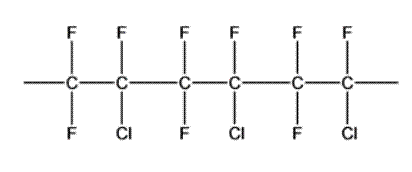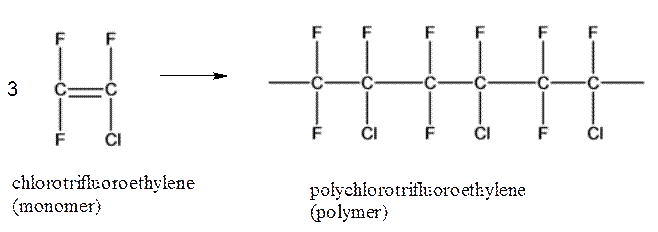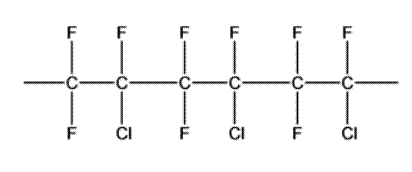
EBK BASIC CHEMISTRY
5th Edition
ISBN: 8220101472335
Author: Timberlake
Publisher: PEARSON
expand_more
expand_more
format_list_bulleted
Concept explainers
Question
Chapter 17, Problem 17.61FU
Interpretation Introduction
Interpretation: The expanded structural formula for a portion of polychlorotrifluoroethylene, PCTFE formed from three monomers of chlorotrifluoroethylene should be drawn.
Concept Introduction: The substance which is made up of molecules with a large molecular mass formed by repeating structural units which are connected by covalent bonds are said to be the
Expert Solution & Answer
Answer to Problem 17.61FU

Explanation of Solution
Polychlorotrifluoroethylene, PCTFE, is a polymer in nature, made up from the chlorotrifluoroethylene (monomer) by the process said to be addition
In addition polymerization process, there is no loss of any small molecule and the polymer is formed by simple linking of monomers.

Conclusion

Want to see more full solutions like this?
Subscribe now to access step-by-step solutions to millions of textbook problems written by subject matter experts!
Students have asked these similar questions
Select the stronger base from each pair of compounds.
(a) H₂CNH₂ or EtzN
(b)
CI
or
NH2
NH2
(c)
.Q
or EtzN
(d)
or
(e)
N
or
(f)
H
or
H
4. Provide a clear arrow-pushing mechanism for each of the following reactions. Do not skip proton
transfers, do not combine steps, and make sure your arrows are clear enough to be interpreted
without ambiguity.
a.
2.
1. LDA
3. H3O+
HO
b.
H3C CH3
H3O+
✓ H
OH
Chapter 17 Solutions
EBK BASIC CHEMISTRY
Ch. 17.1 - LEARNING GOAL Write the IUPAC names and draw the...Ch. 17.1 - Prob. 17.2QAPCh. 17.1 - Prob. 17.3QAPCh. 17.1 - Prob. 17.4QAPCh. 17.1 - Prob. 17.5QAPCh. 17.1 - Prob. 17.6QAPCh. 17.1 - Prob. 17.7QAPCh. 17.1 - Prob. 17.8QAPCh. 17.1 - Prob. 17.9QAPCh. 17.1 - Prob. 17.10QAP
Ch. 17.2 - Prob. 17.11QAPCh. 17.2 - Prob. 17.12QAPCh. 17.2 - Prob. 17.13QAPCh. 17.2 - Prob. 17.14QAPCh. 17.2 - Prob. 17.15QAPCh. 17.2 - Prob. 17.16QAPCh. 17.2 - Prob. 17.17QAPCh. 17.2 - Prob. 17.18QAPCh. 17.2 - Prob. 17.19QAPCh. 17.2 - Prob. 17.20QAPCh. 17.2 - Prob. 17.21QAPCh. 17.2 - Prob. 17.22QAPCh. 17.2 - Prob. 17.23QAPCh. 17.2 - Prob. 17.24QAPCh. 17.3 - Prob. 17.25QAPCh. 17.3 - Prob. 17.26QAPCh. 17.3 - Prob. 17.27QAPCh. 17.3 - Prob. 17.28QAPCh. 17.4 - Prob. 17.29QAPCh. 17.4 - Prob. 17.30QAPCh. 17.4 - Prob. 17.31QAPCh. 17.4 - Prob. 17.32QAPCh. 17.4 - Prob. 17.33QAPCh. 17.4 - Prob. 17.34QAPCh. 17.5 - Prob. 17.35QAPCh. 17.5 - Prob. 17.36QAPCh. 17.5 - Prob. 17.37QAPCh. 17.5 - Prob. 17.38QAPCh. 17.5 - Prob. 17.39QAPCh. 17.5 - Prob. 17.40QAPCh. 17.6 - Prob. 17.41QAPCh. 17.6 - Prob. 17.42QAPCh. 17.6 - Prob. 17.43QAPCh. 17.6 - Prob. 17.44QAPCh. 17.6 - Prob. 17.45QAPCh. 17.6 - Prob. 17.46QAPCh. 17.6 - Prob. 17.47QAPCh. 17.6 - Prob. 17.48QAPCh. 17.6 - Prob. 17.49QAPCh. 17.6 - Prob. 17.50QAPCh. 17.6 - Prob. 17.51QAPCh. 17.6 - Draw the condensed structural formula for each of...Ch. 17.7 - Write the common name for each of the following:Ch. 17.7 - Prob. 17.54QAPCh. 17.7 - Prob. 17.55QAPCh. 17.7 - Prob. 17.56QAPCh. 17.7 - Prob. 17.57QAPCh. 17.7 - Prob. 17.58QAPCh. 17.7 - Prob. 17.59QAPCh. 17.7 - Prob. 17.60QAPCh. 17 - Prob. 17.61FUCh. 17 - 17.62 New polymers have been synthesized to...Ch. 17 - Prob. 17.63FUCh. 17 - Prob. 17.64FUCh. 17 - Prob. 17.65UTCCh. 17 - Prob. 17.66UTCCh. 17 - Prob. 17.67UTCCh. 17 - Prob. 17.68UTCCh. 17 - Prob. 17.69AQAPCh. 17 - Prob. 17.70AQAPCh. 17 - Prob. 17.71AQAPCh. 17 - Prob. 17.72AQAPCh. 17 - Prob. 17.73AQAPCh. 17 - Prob. 17.74AQAPCh. 17 - Prob. 17.75AQAPCh. 17 - Prob. 17.76AQAPCh. 17 - Prob. 17.77AQAPCh. 17 - Prob. 17.78AQAPCh. 17 - Prob. 17.79AQAPCh. 17 - Prob. 17.80AQAPCh. 17 - Prob. 17.81AQAPCh. 17 - Prob. 17.82AQAPCh. 17 - Prob. 17.83AQAPCh. 17 - Prob. 17.84AQAPCh. 17 - Prob. 17.85AQAPCh. 17 - Prob. 17.86AQAPCh. 17 - Prob. 17.87AQAPCh. 17 - Prob. 17.88AQAPCh. 17 - Prob. 17.89AQAPCh. 17 - Prob. 17.90AQAPCh. 17 - Prob. 17.91AQAPCh. 17 - Prob. 17.92AQAPCh. 17 - Draw the condensed structural formula for each of...Ch. 17 - Prob. 17.94AQAPCh. 17 - Prob. 17.95AQAPCh. 17 - Prob. 17.96AQAPCh. 17 - Prob. 17.97CQCh. 17 - Prob. 17.98CQCh. 17 - Prob. 17.99CQCh. 17 - Prob. 17.100CQCh. 17 - Prob. 17.101CQCh. 17 - Prob. 17.102CQ
Knowledge Booster
Learn more about
Need a deep-dive on the concept behind this application? Look no further. Learn more about this topic, chemistry and related others by exploring similar questions and additional content below.Similar questions
- 2. Provide reagents/conditions to accomplish the following syntheses. More than one step is required in some cases. a. CH3arrow_forwardIdentify and provide an explanation that distinguishes a qualitative and quantitative chemical analysis. Provide examples.arrow_forwardIdentify and provide an explanation of the operational principles behind a Atomic Absorption Spectrometer (AAS). List the steps involved.arrow_forward
- Instructions: Complete the questions in the space provided. Show all your work 1. You are trying to determine the rate law expression for a reaction that you are completing at 25°C. You measure the initial reaction rate and the starting concentrations of the reactions for 4 trials. BrO³¯ (aq) + 5Br¯ (aq) + 6H* (aq) → 3Br₂ (l) + 3H2O (l) Initial rate Trial [BrO3] [H*] [Br] (mol/L) (mol/L) | (mol/L) (mol/L.s) 1 0.10 0.10 0.10 8.0 2 0.20 0.10 0.10 16 3 0.10 0.20 0.10 16 4 0.10 0.10 0.20 32 a. Based on the above data what is the rate law expression? b. Solve for the value of k (make sure to include proper units) 2. The proposed reaction mechanism is as follows: i. ii. BrО¸¯ (aq) + H+ (aq) → HBrO3 (aq) HBrO³ (aq) + H* (aq) → H₂BrO3* (aq) iii. H₂BrO³* (aq) + Br¯ (aq) → Br₂O₂ (aq) + H2O (l) [Fast] [Medium] [Slow] iv. Br₂O₂ (aq) + 4H*(aq) + 4Br(aq) → 3Br₂ (l) + H2O (l) [Fast] Evaluate the validity of this proposed reaction. Justify your answer.arrow_forwardе. Д CH3 D*, D20arrow_forwardC. NaOMe, Br Brarrow_forward
- Please predict the products for each of the following reactions: 1.03 2. H₂O NaNH, 1. n-BuLi 2. Mel A H₂ 10 9 0 H2SO4, H₂O HgSO4 Pd or Pt (catalyst) B 9 2 n-BuLi ♡ D2 (deuterium) Lindlar's Catalyst 1. NaNH2 2. EtBr Na, ND3 (deuterium) 2. H₂O2, NaOH 1. (Sia)2BH с Darrow_forwardin the scope of ontario SCH4U grade 12 course, please show ALL workarrow_forwardIs the chemical reaction CuCl42-(green) + 4H2O <==> Cu(H2O)42+(blue) + 4Cl- exothermic or endothermic?arrow_forward
arrow_back_ios
SEE MORE QUESTIONS
arrow_forward_ios
Recommended textbooks for you
 ChemistryChemistryISBN:9781305957404Author:Steven S. Zumdahl, Susan A. Zumdahl, Donald J. DeCostePublisher:Cengage Learning
ChemistryChemistryISBN:9781305957404Author:Steven S. Zumdahl, Susan A. Zumdahl, Donald J. DeCostePublisher:Cengage Learning ChemistryChemistryISBN:9781259911156Author:Raymond Chang Dr., Jason Overby ProfessorPublisher:McGraw-Hill Education
ChemistryChemistryISBN:9781259911156Author:Raymond Chang Dr., Jason Overby ProfessorPublisher:McGraw-Hill Education Principles of Instrumental AnalysisChemistryISBN:9781305577213Author:Douglas A. Skoog, F. James Holler, Stanley R. CrouchPublisher:Cengage Learning
Principles of Instrumental AnalysisChemistryISBN:9781305577213Author:Douglas A. Skoog, F. James Holler, Stanley R. CrouchPublisher:Cengage Learning Organic ChemistryChemistryISBN:9780078021558Author:Janice Gorzynski Smith Dr.Publisher:McGraw-Hill Education
Organic ChemistryChemistryISBN:9780078021558Author:Janice Gorzynski Smith Dr.Publisher:McGraw-Hill Education Chemistry: Principles and ReactionsChemistryISBN:9781305079373Author:William L. Masterton, Cecile N. HurleyPublisher:Cengage Learning
Chemistry: Principles and ReactionsChemistryISBN:9781305079373Author:William L. Masterton, Cecile N. HurleyPublisher:Cengage Learning Elementary Principles of Chemical Processes, Bind...ChemistryISBN:9781118431221Author:Richard M. Felder, Ronald W. Rousseau, Lisa G. BullardPublisher:WILEY
Elementary Principles of Chemical Processes, Bind...ChemistryISBN:9781118431221Author:Richard M. Felder, Ronald W. Rousseau, Lisa G. BullardPublisher:WILEY

Chemistry
Chemistry
ISBN:9781305957404
Author:Steven S. Zumdahl, Susan A. Zumdahl, Donald J. DeCoste
Publisher:Cengage Learning

Chemistry
Chemistry
ISBN:9781259911156
Author:Raymond Chang Dr., Jason Overby Professor
Publisher:McGraw-Hill Education

Principles of Instrumental Analysis
Chemistry
ISBN:9781305577213
Author:Douglas A. Skoog, F. James Holler, Stanley R. Crouch
Publisher:Cengage Learning

Organic Chemistry
Chemistry
ISBN:9780078021558
Author:Janice Gorzynski Smith Dr.
Publisher:McGraw-Hill Education

Chemistry: Principles and Reactions
Chemistry
ISBN:9781305079373
Author:William L. Masterton, Cecile N. Hurley
Publisher:Cengage Learning

Elementary Principles of Chemical Processes, Bind...
Chemistry
ISBN:9781118431221
Author:Richard M. Felder, Ronald W. Rousseau, Lisa G. Bullard
Publisher:WILEY
Molecular spectroscopy; Author: Vidya-mitra;https://www.youtube.com/watch?v=G6HjLIWvCQo;License: Standard YouTube License, CC-BY